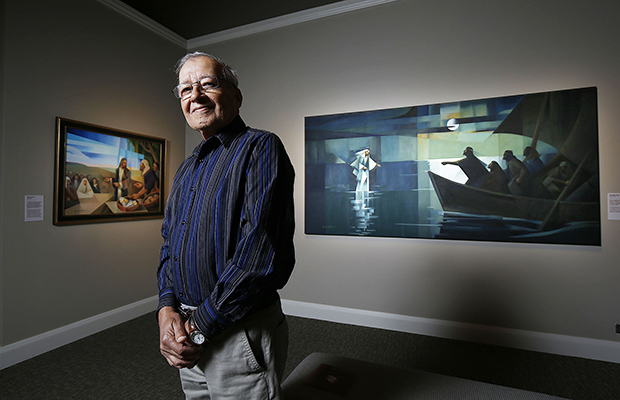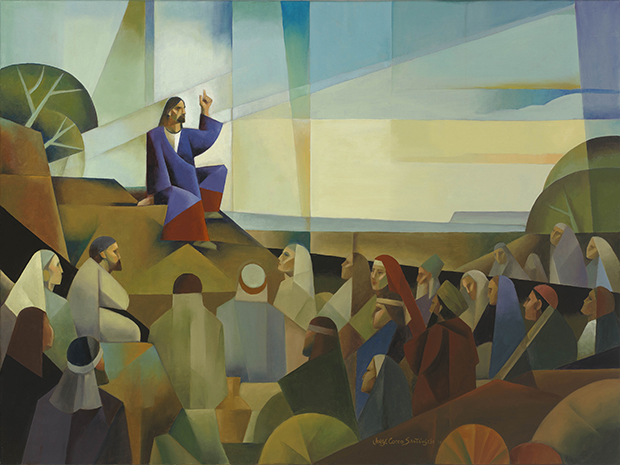“Sacred Events” Exhibit Represents “Global Nature” of the Church
Contributed By Kaitlyn Bancroft, Church News staff writer

Argentine artist Jorge Cocco Santángelo poses for a photo with some of his artwork at the Church History Museum in Salt Lake City on Thursday, May 17, 2018. Photo by Ravell Call, Deseret News.
“When I finish a piece of work, I give tribute to God for this gift that I’ve received because it’s not mine. It was given to me to do this.” —Jorge Cocco Santángelo, artist
Laura Allred Hurtado was first drawn to The Call.
The cubism-influenced painting by Argentine artist Jorge Cocco Santángelo depicts Christ standing before a lake and extending His arm to a boat, where Simon Peter and Andrew are fishing. But it was more than that; Hurtado, who is the global acquisitions art curator at the Church History Museum, found the painting realistic enough to recognize the story while still using complicated color motifs, abstractions, and linear lines. This made it stand out from the other entries at the 10th International Art Competition in 2015, an event which Hurtado said is designed to build the museum’s collection.
“[The Call] didn’t feel like an obvious choice,” she said. “It felt new and it felt fresh.”
Hurtado ultimately acquired the piece, which led to a 21-work commission depicting sacred events from Christ’s life as found in the New Testament. Those works are now in a new Church History Museum exhibit called Jorge Cocco Santángelo: Sacred Events from the Life of Christ that runs from May 17 to October 1.
The paintings, however, are more than simply a new exhibit; they’re an indicator of an increasingly global Church.
“I just felt like I had found something that really resonated with the Church and that Church membership was eager to also expand those visual narratives to represent the global nature of our Church,” Hurtado said.
Hurtado explained that Santángelo’s style is called “sacrocubism,” which combines cubism and sacred subject matters. This helps viewers worry less about exact details, such as clothing and landscapes, and more about the story’s meaning and depth; the abstract element serves as a lens for the story’s real meaning, which is “sometimes hard to comprehend and certainly hard to capture,” she said.
She also said the exhibit becomes part of the Restoration by contrasting with the nearby Mormon Trails exhibit, which shows pioneers as they’re traditionally thought of. The Sacred Events exhibit, however, shows how Jorge and his wife, Myriam, who joined the Church in 1962, “were the trailblazing members of Argentina.”

Argentine artist Jorge Cocco Santángelo poses for a photo with some of his artwork at the Church History Museum in Salt Lake City on Thursday, May 17, 2018. Photo by Ravell Call, Deseret News.
Santángelo, whose son Amiel Cocco acted as his translator, said the exhibit was most influenced by his own testimony and that part of his testimony comes from touching other people through his work.
“In the Restoration, the understanding of the gospel needs diverse languages to be able to understand it completely,” the artist said.
He also said this type of art requires self-renewal to “analyze and awaken those things that are inside,” which helps him find new ideas in events that have been depicted before.
In addition, he feels a “very heavy sense of responsibility” when painting.
“I’m not just painting any landscape or anything, so if I’m not inspired by God, I couldn’t be able to do it,” he said. “When I finish a piece of work, I give tribute to God for this gift that I’ve received because it’s not mine. It was given to me to do this.”

Argentine artist Jorge Cocco Santángelo poses for a photo with some of his artwork at the Church History Museum in Salt Lake City on Thursday, May 17, 2018. Photo by Ravell Call, Deseret News.

Argentine artist Jorge Cocco Santángelo poses for a photo with some of his artwork at the Church History Museum in Salt Lake City on Thursday, May 17, 2018. Photo by Ravell Call, Deseret News.

This painting, titled Sermon on the Mount, by Argentine artist Jorge Cocco Santángelo is part of a new exhibit at the Church History Museum in downtown Salt Lake City.

This painting, titled The Last Supper, by Argentine artist Jorge Cocco Santángelo is part of a new exhibit at the Church History Museum in downtown Salt Lake City.
